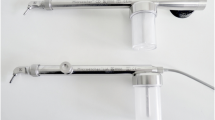Abstract:
Bracket loss is a severe complication in the course of orthodontic treatment, especially when using lingual appliances. High adhesive strength between bracket and tooth is therefore an important requirement for the successfull integration of lingual orthodontics into everyday practice.
The present article examines the influence of intraoral sandblasting prior to etching on the adhevise strength of indirect bonding. The shear bond strength of 20 cylinders made of composite were measured 24 hours after these had been bonded onto the enamel of bovine teeth. The enamel was prepared by sandblasting (Microetcher®, 50 μm AI2O3) for 3 seconds prior to bonding, followed by 30 seconds of enemal etching with 37% phosphoric acid. Twenty specimens were tested without sandblasting in the control group.
The results show that intraoral sandblasting prior to etching can significantly (p < 0.001) increase the adhesive strength between enamel and bonding material. Thus intraoral sandblasting is an integral part of the indirect bonding record described in the second section of this article.
Zusammenfassung:
Der Verlust eines Brackets stellt besonders in der Lingualtechnik eine erhebliche Komplikation im Behandlungsablauf dar. Hohe Verbundfestigkeiten zwischen Bracket und Zahnoberfläche sind daher eine wichtige Voraussetzung für die erfolgreiche Integration der Lingualtechnik in die tägliche Praxis.
Die vorliegende Arbeit untersucht den Einfluss des intraoralen Sandstrahlens vor der Säureätzung auf die resultierende Verbundfestigkeit bei einer indirekten Klebung. Dazu wurden die Biegebruchfestigkeiten von 20 indirekt hergestellten Kunststoffzylindern 24 Stunden nach dem Kleben auf Rinderschmelz gemessen. Der Schmelz wurde vor dem Bekleben drei Sekunden sandgestrahlt (Microetcher®, 50 μm AI2O3) und anschließend für 30 Sekunden mit 37%iger Phosphorsäure angeätzt.Bei der Kontrollgruppe mit ebenfalls 20 Proben wurde auf das Sandstrahlen verzichtet.
Die Ergebnisse zeigen, dass durch intraorales Sandstrahlen vor dem Anätzen die Verbundfestigkeit zwischen Schmelz und Komposit bei einer indirekten Klebung signifikant (p < 0,001) erhöht werden kann. Intraorales Sandstrahlen ist damit ein wesentlicher Teil des im zweiten Abschnitt dieses Beitrags vorgestellten indirekten Klebeprotokolls.
Similar content being viewed by others
Author information
Authors and Affiliations
Additional information
Submitted: 12 Dec 1999. Accepted: 2 Feb 2000.
Rights and permissions
About this article
Cite this article
Wiechmann, D. Lingual Orthodontics (Part 3): Intraoral Sandblasting and Indirect Bonding. Journal of Orofacial Orthopedics / Fortschritte der Kieferorthopädie 61, 280–291 (2000). https://doi.org/10.1007/s000560050013
Issue Date:
DOI: https://doi.org/10.1007/s000560050013




